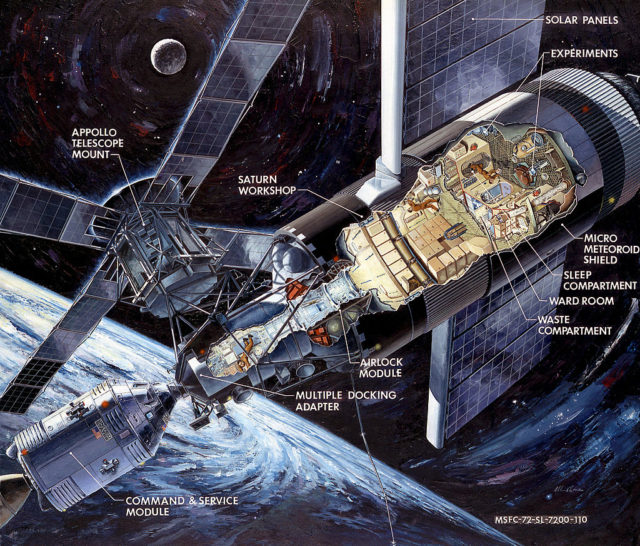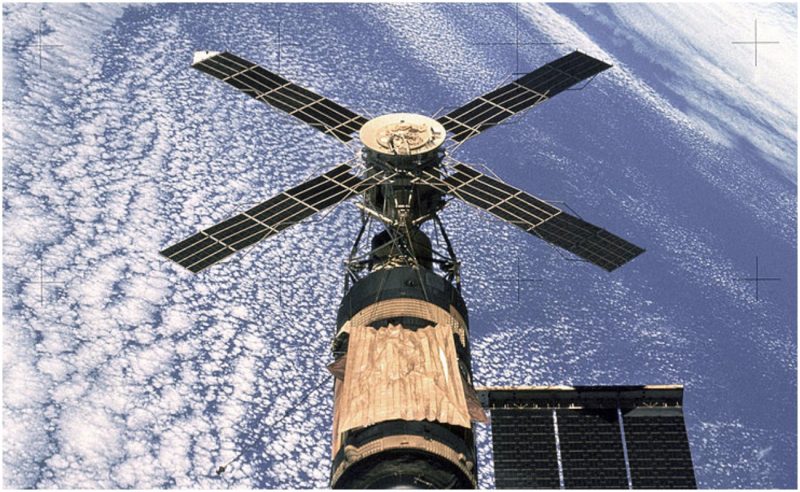Skylab was the first and only space station launched by the United States and visited only by American astronauts. It was launched to a lower-Earth orbit in 1973 and remained there until 1979, when it re-entered the atmosphere and partially burned out. A number of pieces of the dissolved space station landed near the Australian city of Perth and can nowadays be seen on display at the U.S. Space and Rocket Center in Huntsville, Alabama. During its six years of orbiting the planet, Skylab was visited by four astronaut crews who spent a total of 171 days aboard the space station.
As its name suggests, Skylab was a space laboratory. In fact, it was a state-of-the-art research outpost equipped with advanced technology, which enabled the Skylab crews to conduct extensive experimentation in various fields, including medicine, solar observation, deep stellar astronomy, Earth terrain mapping, and space photography. Skylab 4, the final crew aboard the space station, spent 84 days in low orbit. At the time, this was the longest period any astronaut crew had spent in space. The crew consisted of astronauts Gerald P. Carr, Edward G. Gibson, and Wilson R. Pogue.
Aside from conducting groundbreaking scientific experiments, such as photographing a solar flare for the first time in history and filming the Comet Kohoutek as it grazed the Earth’s atmosphere, the Skylab 4 crew will remain known for its organizing the first and only labor strike that took place in space.

Skylab 3, the crew that operated the space station before the Skylab 4 crew, maintained an unbelievably fast tempo of conducting experiments and managed to acquire far more valuable data than their mission parameters dictated. Therefore, before launching the Skylab 4 crew into orbit, NASA decided to task the Skylab 4 astronauts with a lot more experiments than was originally intended.
When Carr, Gibson, and Pogue boarded the space station on November 16, 1973, their schedule was so packed that they barely had any time to eat, sleep, or do anything except work. Every single hour of their 84-day mission had been carefully planned in advance, and mission control pressured them to finish all of their tasks on time. This caused the astronauts to become increasingly frustrated and fatigued during the first six weeks of the mission. Furthermore, all three men of the Skylab 4 crew were rookie astronauts who had never been in space before boarding the Skylab station. Their frustration was amplified by the isolated and claustrophobic environment of the station, the strict regime of non-stop labor, and the effects of microgravity, which caused the pilot Pogue to develop space sickness. They demanded more leisure time, but NASA was determined to keep them occupied.
On December 28, 1973, the Skylab 4 crew decided to express their dissatisfaction with the mission parameters by organizing a day-long labor strike. They turned off their transmitters and refused to communicate with mission control. NASA repeatedly tried to initiate communication with the crew, but the crew chose not to respond. The men stopped working for a day: They abandoned their tightly-scheduled daily tasks and engaged in leisurely activities. Carr and Pogue spent the day in the living quarters, where they looked out of the window and enjoyed the majestic view, and Gibson conducted non-scheduled observations of the Sun through Skylab’s solar console.

Meanwhile, mission control experienced a day of panic. Since the rookie Skylab 4 crew had spent an unusually long time in space, NASA suspected that they might have developed some collective space neurosis that caused them to defy the orders of the mission control. The panic ceased the next day, when the Skylab 4 crew turned on the station’s transmitters and re-established communication. NASA agreed to reduce the workload for the crew and gave them some more leisure time in the following six weeks. Despite the labor strike and their dissatisfaction with the working conditions, the Skylab 4 crew returned to Earth on February 8, 1974, having completed all tasks assigned by the mission control plus dozens of additional tasks that were added to the mission after primary objectives were completed.
However, none of the astronauts of the Skylab 4 crew ever flew again. All three of them resigned from NASA in the following years, but Edward Gibson continued researching Skylab’s data on solar physics as a senior scientist of the Aerospace Corp. of Los Angeles. The day-long labor strike urged NASA to change the workload conditions for all future space missions: in order to remain as stress-free as possible, contemporary astronauts are allowed to spend more time relaxing than the astronauts of the 1970s. Also, after the Skylab mutiny, NASA established a rule which states that at least one crew member aboard any space station has to be a veteran astronaut who has experience with the harsh working conditions, the effects of microgravity, and the stresses related to life in lower Earth orbit.
